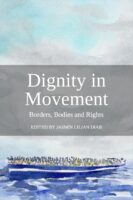Last Updated on September 3, 2021 by themigrationnews

In the book Dignity in Movement: Borders, Bodies and Rights, Jasmin Lilian Diab as an editor, attempts to knit the expertise of academicians across disciplines with the motive to cover wide-ranging aspects related to migration. The editor is a professional in Migration Studies, currently positioned as Assistant Professor at the Lebanese American University. She has previously been an international consultant at UNHCR, WHO, and is the co-founder of MILAMET. The seemingly effortless network synthesis presented in the book evidences her invaluable experience as an editor for various journals. The book has 22 chapters written by more than 22 specialists in the backdrop of the current ‘migration crises.’ The book, being a work of its time, strives to enrich the discourse on human movement so that no person is left behind. Therefore, despite opening with quantitative data on the migration crisis, the book finds its locus in qualitative analysis such as nascent conceptualization with varied definitions by different enumerating organizations.
The book is based on the hypothesis that the definitions in the migration discourse are developing. The central research question is to unravel the influence of various factors formulating the definition of migration. It is, therefore, the book in its main theme provides the reader with a theoretical understanding of the existing international and national institutions, human rights debates, treaties, and legal frameworks as to how migrants, refugees, and immigrants are differentiated. It is here that the Foucauldian lens of governmentality is used to unveil the state as a non-neutral arbiter. The book explores this theme through various case studies, empirical data, ethnographic field-study, participant observations, temporal and spatial analysis regarding displaced persons. The lucid writing style, along with reader-oriented explanation, helps in critical thinking that state creates power hierarchy by producing knowledge on displacement through differential labels, definitions, representations, and categories of migrants and refugees. The book is not a criticism of existing frameworks, but it is an empathetic effort aiding a comprehensive understanding of how governance can create, normalize and fix humans into categories through ritualized performance. Wide-ranging examples in the book substantiate this argument, such as the recent Global Compact for Migration, the Argentinian Migration Laws, colonial violence in Bosnia-Croatia frontiers; internally displaced people of South Sudan; and Tamils in Sri Lanka. The case of North Jordan is an intriguing example of governing protracted displacement.
The book has an encompassing theme dealing with different kinds of migration based on race, gender, region, class, geography, environment, and many more aspects. Case studies are vivid in explaining the reasons for migration and how a person’s identity can change his/her experiences on the journey. In this process, the organizations involved in arranging migration are equally important. The book uses an intergenerational case study to highlight labour migration management by the state as a win-win for the worker, destination, and labour sending countries. A significant contribution of the book is its fresh perspective on militarism, imperialism, and geopolitical intervention as factors contributing to stringent and often inhuman border management practices. Today, governments pay private companies to manage prisons and detention centers. Under this neo-liberalism is the gamut of neo-colonialism when private corporations profit by confining migrants fleeing violence.
Further, interviews with migrants elucidate the existence of multiple and fused oppressions. The case of mutual support groups by women migrants in Nicaragua captures a desperate but unfulfilled resistance. According to Lugones (2008), the modern/colonial gender system sustains these oppressions. The grey zone between oppression and resistance is picturesque in the book. The reader is left to wonder steps for strong resistance ranging from- opposition to the short-term welfarist policy of the state to advocacy for a long-term capability, enhancing community experiences led policy.
The book has tried to cover every aspect of human displacement, starting from definition and ultimately covering the chain of processes. The case study of migration, asylum, and unaccompanied children from Central America’s turbulent Northern Triangle presents a case of this unending process (even if a child accompanies). It shows how unilateral policies of a country are bound to fail if the problem is regional. Further, COVID-19 has brought to face the need for a collective and collaborative framework. A striking keynote of the book is its understanding of migration as a cycle. The example of the European Union Readmission Agreement shows that deportation is not the end of a migration cycle but a rupture in a complex process that affects and disrupts the lives of deported and dependents (Collyer 2018). Tracing from the book, the cycle includes the situation and the status of a migrant after completion of the entire process; it covers the conditions in which he/she leaves his/her home, whether it was by force or voluntary; the process by which he/she starts the journey whether it was legal or illegal; role and support of his/her home country in migration; international agencies encountered in the journey; the process of acceptance by foreign land; his/her condition on new place; if he/she wants to return to the homeland or not. The book is a masterpiece in covering all these varied aspects in detail.
Moreover, the description of these aspects is covered not by abstract theoretical dictums but by narratives. These narratives have the potential to develop empathy in the reader. The reader is bugged by the weirdness that these human-made cycles sometimes do not end, but human life ends in the process.
The book covers many identities, but the women-sensitive coverage of the issue is extraordinary. It is phenomenally different from mainstream state-centric literature and offers a human and community face of the problem. All the chapters deal with different stories, frameworks, and situations but with a common thread, i.e., the current migration law (international or national). The book, in some chapters, uses the historical study of law to show how migration handling was better in the past, but it has degraded with time. It shows we are, in a real sense, becoming less civic. The book brings case studies of many national or international bodies and laws to prove this perpetual inefficiency, for example, International Organization for Migration; (Avellaneda law, Videla law, DNU) Argentina; Inter American Court of Human Rights; New York Declaration for Refugees and Migrants; Global Compact for Migration; Kafala System; Agenda for the protection of cross border displaced person in the context of disasters and climate change; National Agency for the Placement and Protection of Indonesian Migration Workers; UN Refugee convention.
One of the limitations of the book is that it uses mainstream binaries of gender. The gender/sex is dealt in binary of male and female without giving attention to the third gender/sex. Given the emerging nature of migration studies, this limitation is understandable. Another limitation is that the book is a mere diagnosis. Despite a promising introduction, the book lacks a policy way forward. It is the most significant limitation, as it undermines both: the seriousness of each chapter in the book, and the commitment to the issue. A final limitation is the lack of other methods to verify the case study, interviews, and field work. Thus, despite the merit of linking the theory and the empirical, the book is shadowed by the possibility of the researcher’s subjective bias. In the chapter dealing with the violence on the Croatia-Bosnia border, the author uses unguided conversation to dilute positionality, bias and other methodological issues. However, the attempt is half-hearted because the reader feels that the author is continuously using bias in the act of abstracting the arguments from the conversation. Further, the tool has narrow scope and questionable reliability.
The work of various authors in the book highlights that migration is not a singular entity. It is in myriad forms, nature, and unending process. The work and effort from diverse fields hold relevance in the crisis of our times. Overall, the book is stimulating, articulate, reader-oriented, and connects theory and narratives. It is a good read for researchers, think-tank professionals, and students of the humanities discipline. It contributes to migration studies, IR, developmental studies, law, ethnographic studies, political science, labour studies, women studies, child-welfare studies, and policymaking. It is beyond doubt that the work can enthrall an ordinary person too by the heart-touching case studies and pictures used in the book. The book convincingly presents the case that existing actions are not sufficient in human movement to provide human dignity. Each chapter is eloquent in its way forward that the ‘migration crisis’ can end by providing meaningful rights to human movement. The book is coherent in its message that to attain these rights, we must act together.
REFERENCES
Lugones, María. 2008. ‘Colonialidad y Género’, Tabula Rasa, no. 9. (July– December): 73–101. https://www.redalyc.org/articulo.oa?id=39600906
Collyer, Michael. 2018. ‘Paying to Go: Deportability as Development’, in After Deportation: Ethnographic Perspectives, edited by Khosravi, S., 105–125. Palgrave Macmillan.

Upasana Detha holds M.A. in International relations from Jawaharlal Nehru University, New Delhi. She pursued her B.A. in Political science (Honors) from Lady Shri Ram College for Women, University of Delhi. She has keen interest in diplomacy, global governance, multilateral negotiations, gender, environment, public policy, sustainable development, etc. She has completed a course on understanding conflict at the Geneva Center for Security Sector Governance. She was a part of the Centre for Civil Society’s young leaders e-policy cohort. She enrolled in the course on COVID-19, disaster risk management and our future at the Gujarat Institute of Disaster Management. Her constant motivation is eagerness to learn and unlearn.
